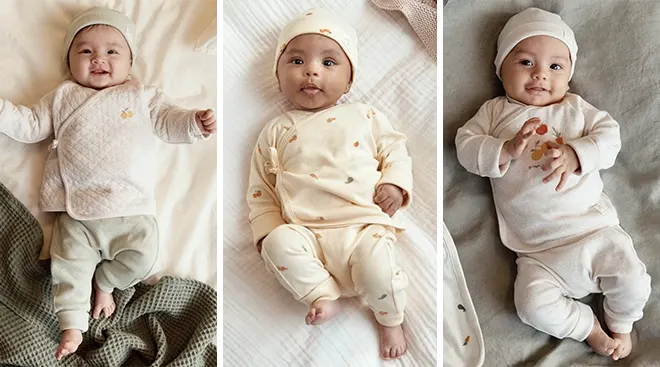Uncategorized
The Importance of Choosing Breathable Fabrics for Kids’ Clothing
When it comes to children’s clothing, comfort and functionality are top priorities. One key factor in ensuring your child’s clothing keeps them comfortable throughout the day is the breathability of the fabric. Breathable fabrics allow air to circulate, helping to regulate body temperature and prevent overheating or excessive sweating. This is particularly important for kids, who are constantly on the move and may be more sensitive to discomfort caused by clothing. In this article, we will explore the importance of breathable fabrics in kids’ clothing and how to make the best fabric choices for your little one’s wardrobe.
1. What Does Breathable Fabric Mean?
Breathable fabrics are those that allow air to pass through them, ensuring that moisture from sweat evaporates and does not build up against the skin. This feature helps maintain a comfortable body temperature, keeping your child cool during warm weather and warm during colder months.
Some common breathable fabrics include cotton, linen, bamboo, and merino wool, each of which has unique qualities that make them ideal for kids’ clothing.

2. Why Breathability Matters for Kids’ Clothing
Prevents Overheating
Children are naturally more active than adults and often play outside or engage in physical activities. Breathable fabrics help to regulate body temperature by allowing sweat to evaporate and heat to escape, reducing the risk of overheating. Overheating can lead to discomfort, irritability, and even heat-related illnesses, making breathable fabrics a must for kids’ clothing.
Reduces Skin Irritation
Moisture-wicking fabrics can help reduce the risk of skin irritations such as rashes or chafing, which can occur when sweat is trapped between the fabric and the skin. Breathable materials allow the skin to breathe, preventing the buildup of moisture that can lead to these uncomfortable issues.
Enhances Comfort
Kids are more likely to feel comfortable and stay focused on their activities when they are not distracted by overly warm or damp clothing. Breathable fabrics create a comfortable, cool environment for kids, making them ideal for everyday wear, especially during physical activities or hot weather.
Ideal for Sensitive Skin
Children, especially infants and toddlers, tend to have more sensitive skin than adults. Choosing soft, breathable fabrics that are gentle on the skin can help avoid discomfort or reactions caused by harsh materials. Cotton, for instance, is hypoallergenic and soft, making it a great option for kids with sensitive skin.

3. Best Breathable Fabrics for Kids’ Clothing
Cotton
Cotton is one of the most popular and widely used breathable fabrics for kids. Its natural fibers are soft, lightweight, and absorb moisture well. Cotton allows air to circulate, which helps keep the body cool and dry. It’s perfect for everything from t-shirts and dresses to underwear and pajamas.
Linen
Linen is another excellent breathable fabric known for its ability to keep the body cool in hot weather. It’s made from the flax plant and is lightweight, durable, and highly breathable. While linen wrinkles easily, its natural qualities make it a great choice for summer wear, such as shorts, dresses, and lightweight tops.
Bamboo
Bamboo fabric is soft, eco-friendly, and highly breathable. It naturally wicks moisture away from the skin and helps to regulate body temperature. Bamboo clothing is a great choice for active kids, as it keeps them comfortable during playtime or sports. It’s also hypoallergenic, making it ideal for children with sensitive skin.
Merino Wool
Merino wool is an excellent breathable fabric that helps regulate body temperature, keeping kids warm in cooler weather and cool during warmer months. It’s moisture-wicking and lightweight, making it ideal for layering. Merino wool is also naturally odor-resistant, which is a bonus for active children.
Hemp
Hemp is a durable and breathable fabric made from the fibers of the hemp plant. It is naturally moisture-wicking, antibacterial, and anti-fungal, making it an excellent option for kids who are active and sweat more. Hemp fabrics are also environmentally friendly, as hemp is a sustainable resource.
4. How to Choose the Right Breathable Fabrics for Your Child
Consider the Season
For warmer weather, opt for lightweight fabrics like cotton, linen, and bamboo that will keep your child cool and comfortable. During colder months, merino wool or a cotton blend can help regulate body temperature while still providing breathability.
Check for Moisture-Wicking Properties
Look for fabrics that are designed to wick moisture away from the skin, such as bamboo or merino wool. This helps to keep your child dry and comfortable, even when they’re sweating during physical activities.
Choose Soft, Gentle Fabrics
Kids have sensitive skin, so prioritize soft fabrics that won’t irritate or chafe. Cotton, bamboo, and merino wool are all gentle options that won’t cause discomfort, even when worn for extended periods.
Opt for Stretch and Flexibility
Kids need freedom of movement to play and explore, so look for breathable fabrics with a bit of stretch, such as cotton blends or bamboo. These fabrics move with your child’s body, providing comfort without restricting their movements.
5. Tips for Caring for Breathable Fabrics
To maintain the breathability and longevity of your child’s clothing, it’s important to follow proper care instructions:
- Wash with Mild Detergent: Use a gentle detergent to preserve the fabric’s softness and breathability.
- Avoid Fabric Softeners: Fabric softeners can coat natural fibers, reducing their breathability and moisture-wicking properties.
- Air Dry When Possible: Air-drying fabrics like cotton and bamboo helps preserve their breathability and prevents shrinking.
- Wash in Cold Water: Washing in cold water helps to prevent damage to the fabric while maintaining its breathability.
6. Conclusion
Choosing breathable fabrics for your child’s clothing is essential for their comfort, health, and well-being. Breathable fabrics help regulate body temperature, reduce skin irritation, and enhance overall comfort, making them perfect for active kids. By selecting fabrics like cotton, linen, bamboo, and merino wool, you can ensure your child stays cool and comfortable, whether they’re playing, learning, or simply relaxing.



